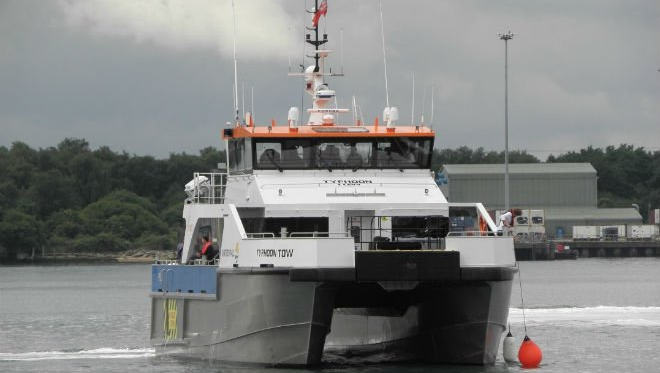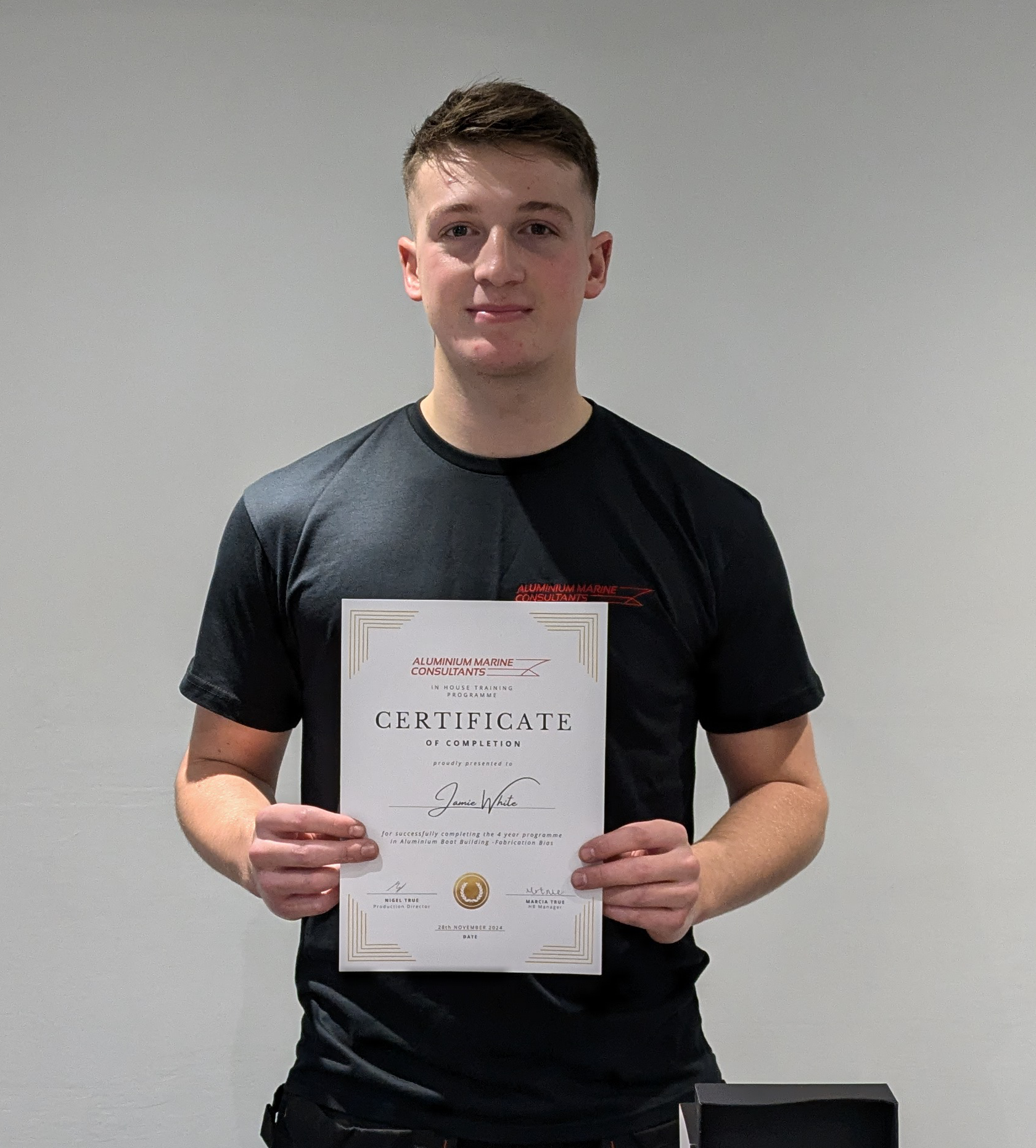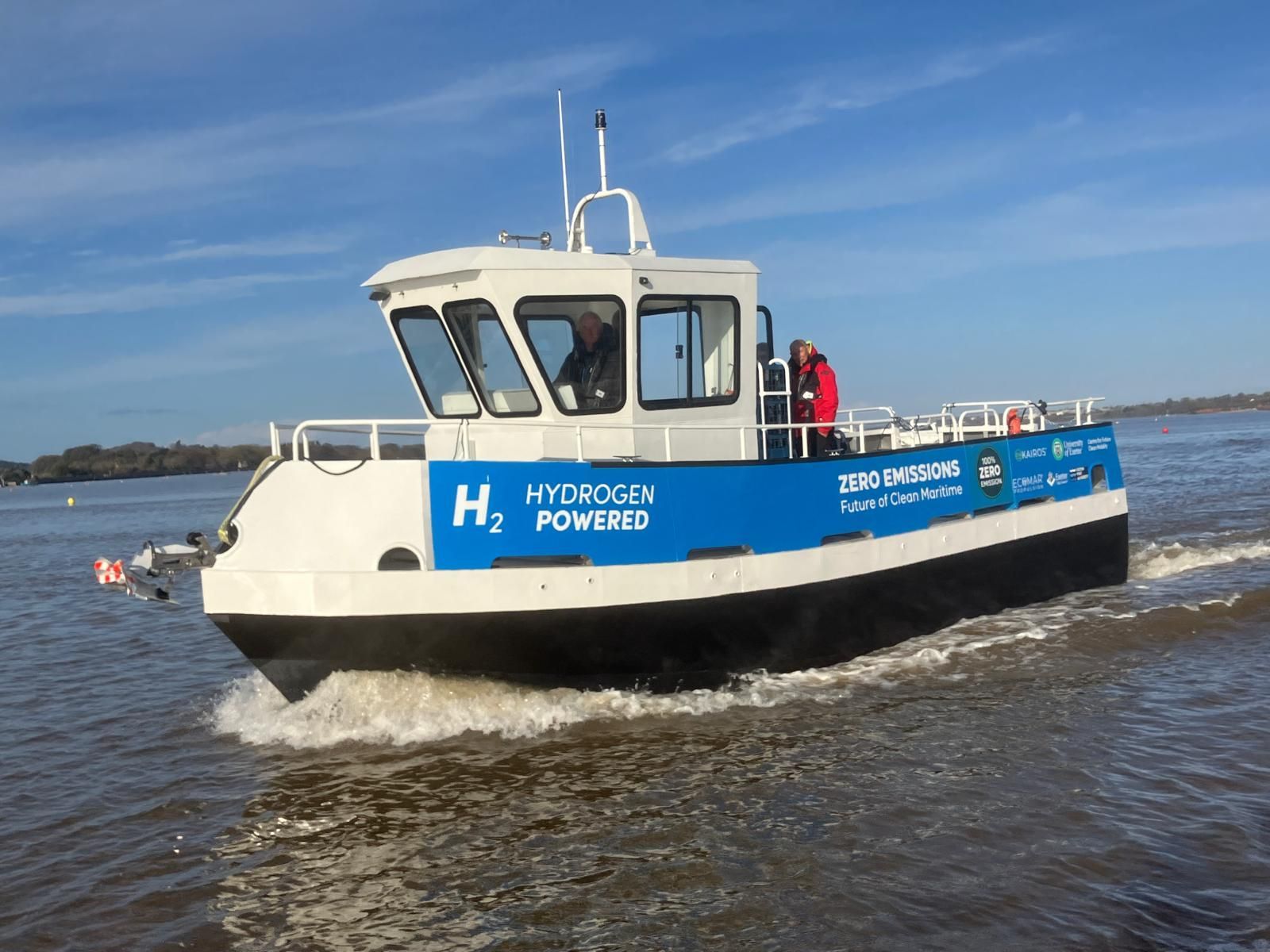
Clarence Boatyard
72 Clarence Road
East Cowes
Isle of Wight
PO32 6TA
A design fit for the current and future demands of the industry.
Like its three sister vessels, offshore wind crew transfer vessel 'Typhoon TOW' “is quite some way above the usual spec”, said Rob Stewart of Aluminium Marine Consultants (AMC).
Peter Richards, Vessel Superintendent at CWind added that the CTV hasn’t just been built to meet the minimum requirements of the work boat code and flag state, but has been built in order to yield maximum days at sea: “The best way to do it is to engineer a design fit for the current and future demands of the industry, rather than working on a just fit-for-purpose vessel.”
However, in order to exceed CWind’s high standard specification and build quality, there was significant collaboration between CWind and AMC in the initial stages to make sure that the scope of works was fully covered and the project milestones were realised on time and on budget. AMC had seen four sister vessels – a pair reaching 24m and another at 22m long - built almost concurrently.
Given the tight delivery time “it meant we had all the different stages there in the shed at the same time: it did push the boundaries... but it’s proved we can do it”, said Mr Stewart.
Secondly, he explained new MCA regulations have raised standards and there was a conscious decision to take on “not just the word but the spirit” of the new guidance: “We wanted to make these boats fully compliant so they could be signed off without any grey areas.”
The capability is continued in the lines of the boat: James Walker of naval architect Walker Marine Design explained that the semi-displacement catamaran hull “has been predominantly designed for its sea keeping abilities... it’s not just focused on transit speed” he said, even though this is a pretty fast 28 knots.
Furthermore, Typhoon TOW has a 1.4m draft, paired with a high waterline which gives plenty of room for the waves to pass through the tunnel between the hulls. “If the wet deck is too low, waves can hit the underside resulting in slamming: it reduces both the sea keeping and the transfer capability of the vessel,” explained Mr Walker.
The specialist wind farm support vessel fendering supplied by RG Seasight in order to give the best possible traction on the tower. The Forward deck area has space for 10 tonnes of cargo and the same on the aft deck although this vessel has been designed more for crew transfer than supplies explained Mr Richards “there’s still room for a crane to be mounted if needed”.
The depth of each hull also gives more than adequate space in the engine compartments: “Typically engine rooms tend to be very cramped… So we consciously tried to give the operator easier access for maintenance” he added.
Propulsion is supplied by a pair of MTU 12V 2000 M72 twelve cylinder engines yielding 1,080 kW each or 2,160kW in all (the other smaller sister vessels being driven by two ten-cylinder engines delivering 900kW with similar effect). These again were chosen with the ‘maximum working hours’ philosophy in mind.
Mr Richards explained the issue for a lot of wind service vessels is that these engines have to cope with extended operating hours as they aren’t just transit vessels, turbine service mode requires continual thrust. Therefore CWind looked at several different manufacturers but MTU, he said, “stood out from the rest... even keeping these vessels running flat-out, we were still within the working range of these particular engines”. He added: “A lot of the other suppliers would only guarantee 70% of the duty cycle, these could guarantee 100%”.
It also helps that the vessels are equipped with MTU’s blue vision new generation automation; a high-speed internet connection allowing the propulsion system to be closely monitored, not only onboard, but also from the shore. This means engine data can be evaluated to allow either operation or fuel consumption to be tweaked in order to give the most efficient performance for the prevailing conditions.
The MTU engines drive the Rolls-Royce Kamewa A3 56 water jets; these come supplied with an integrated, high performance aluminium inlet duct and pre-mounted hydraulic valve block and associated pipe work for simple and effective installation.
A good stop is delivered via a compact, efficient reversing bucket which is able to deliver as much as 70% of the normal forward thrust. The choice fell to Rolls-Royce simply because these water jets delivered around a 10% higher bollard push when compared to competitors’, this not only helps transit efficiency “but keeps the vessel pushed on to the tower in higher sea states” said Mr Walker.
Further, the steering nozzle doesn’t just give the boat a nifty turn of speed, it’s been designed to minimise hydrodynamic losses and minimise vibration. In fact the same concept has been applied to the onboard power gensets: a pair of 19V Cummins Onan ‘Quiet Diesel’ MDKBV units, which have a low sound and vibration profile. These gensets are also particularly easy to operate: there’s an isolated DC console, digital controls providing diagnostics and indicator lights to warn of hazards.
The same attention to comfort has been extended throughout the accommodation areas and wheel house – especially when it comes to noise levels. “We’ve moved on a great deal from the old boats where you really needed ear defenders while in transit,” explained Mr Richards. “The superstructure is resiliently mounted and it’s quiet as a mouse.”
This means that the dozen technicians onboard can rest or chat in the comfortable high-backed KPM passenger seats – plus, the galley is fitted with a microwave and hob as well as water boiler and a fridge freezer so there’s no issue with taking a drink or preparing a light meal.
Up front the navcomm solutions have “some unique features at the request of the client” said Rob Stewart, “centred around a sophisticated communications system”.
However, one of Typhoon TOW’s most valuable features is that it is most definitely not ‘a one off’.
In fact Peter Richards is proud of the fact that this vessel and its three sisters all look incredibly similar - unless you have a tape measure to hand showing that at 24.50m, one pair of these vessels is 2m longer than the other two. “You can’t immediately see the difference – the installations are almost identical apart from a slight difference in the engines and the systems are the same.
The idea being that these four vessels are interchangeable between sites and crew members could walk from one onto the other and would imagine being on the same vessel.”
Rob Stewart concluded: “We are competing in a worldwide market now - it’s no longer a matter of just picking up the phone to a service enquiry and saying ‘we’ll get around to it as soon as we can’.” He added: “It means maturing and if we want to compete we have to be able say, yes and set the standard of support higher. We are building our customer base but we have international standards and an audit trail to give peace of mind to new customers.”
But what of the market conditions? After all, there are these new, big, 24 personnel carriers to compete against. James Walker gave an interesting answer: “Although I expect there’s going to be a loss of interest in the smaller wind support vessels, the 24 personnel carrying boats don’t necessarily give you that much more when it comes to straightforward technician transfer, so these 22m and 24m vessels will remain a good size for a long time to come.”
More news...
If you would like to know more about options to build work boats, hull fabrication, aluminium hot works, business consultation and of course our prices, please get in touch today.
Contact us
Clarence Boatyard
72 Clarence Road
East Cowes
Isle of Wight
PO32 6TA
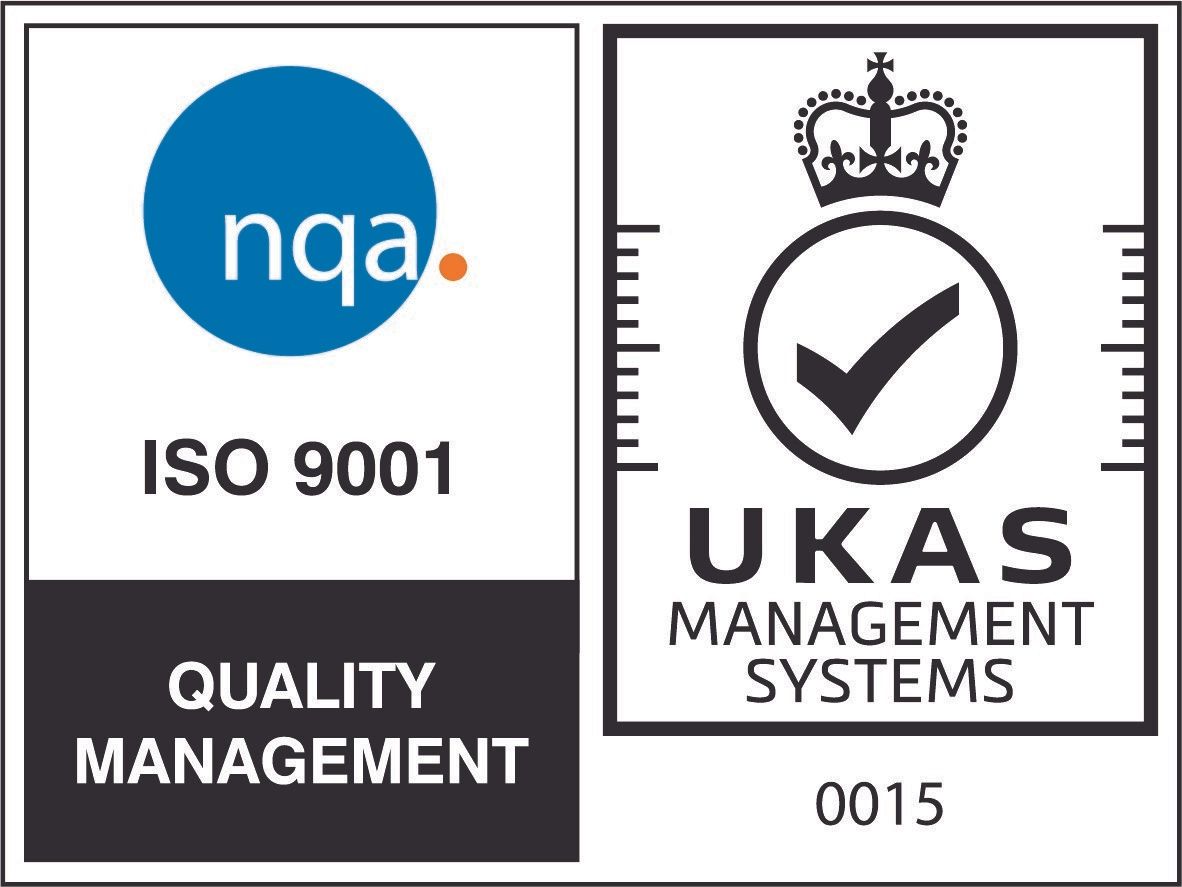
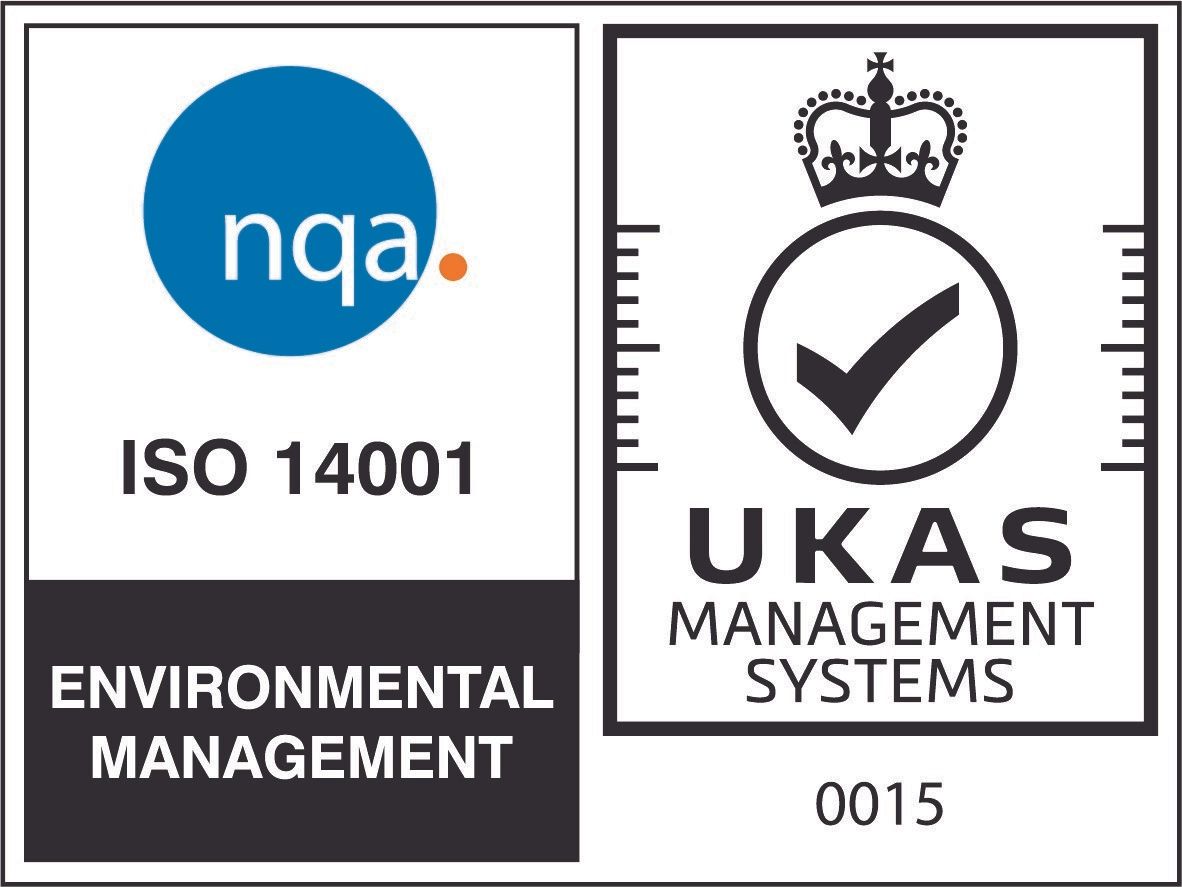
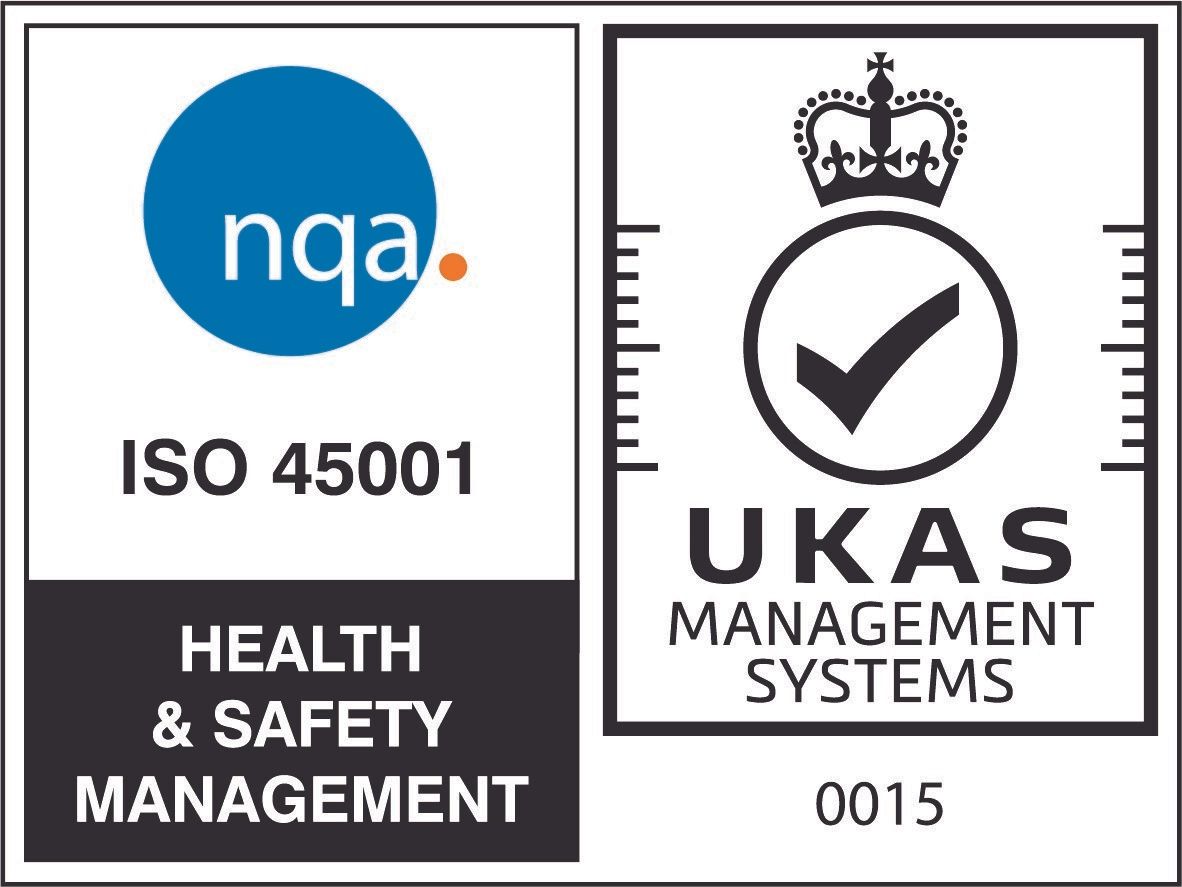


Contact us
Clarence Boatyard
72 Clarence Road
East Cowes
Isle of Wight
PO32 6TA
+44 (0)1983 240693
All Rights Reserved | Aluminium Marine Consultants
Designed & hosted with ![]() by Moose Digital Media
by Moose Digital Media
(An Island Web Design company)
Privacy & Cookie Policy
Admin Login
Designed & hosted with ![]() by Moose Digital Media
by Moose Digital Media
(An Island Web Design company)
Privacy & Cookie Policy
Admin Login
All Rights Reserved | Aluminium Marine Consultants
Designed & hosted with ![]() by Moose Digital Media
by Moose Digital Media
(An Island Web Design company)
Privacy & Cookie Policy
Admin Login

